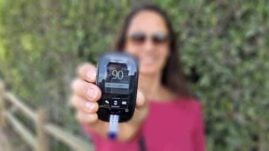For some people with diabetes, the first challenging obstacle you might face is simply getting an accurate diagnosis. LADA is a type of diabetes that’s often misdiagnosed as type 2 diabetes and thus mistreated for years.
In this article, we’ll discuss what LADA is, why it’s easily misdiagnosed, the symptoms, and the best approaches to treating it for healthier, more stable blood sugar levels.

What is LADA?
LADA stands for “latent autoimmune diabetes in adults.” Also known as type 1.5, this form of diabetes is essentially type 1 diabetes but it progresses very slowly, over the course of years instead of months.
For most, it develops after the age of 30.
LADA develops when your immune system begins attacking the insulin-producing cells in your pancreas — also known as beta cells.
The difference between LADA and type 1 diabetes is simply that the immune system’s attack on your beta cells happens much more slowly, which means you continue to produce some insulin much longer than after the onset of type 1 diabetes.
However, this decline in insulin production also progresses much, much more quickly than type 2 diabetes, placing it somewhere between the two conditions.
Why LADA is often misdiagnosed as type 2 diabetes
This slow progression of the disease is why many people with LADA are often misdiagnosed with type 2 diabetes, explains research from the American Diabetes Association’s Diabetes Spectrum.
“Typically, the clinical features of type 1 diabetes seen in LADA include a lower BMI compared to what is typical in type 2 diabetes,” explains the study.
“Although it has a closer pathophysiological relationship to type 1 diabetes, LADA is often misdiagnosed and treated as type 2 diabetes. This results in insufficient glycemic control and harm to patients.”
At first, LADA can be managed like the earlier stages of type 2 diabetes — with changes in diet and exercise, and then, perhaps some oral diabetes medications.
This stage could persist for years until you are producing so little insulin that these treatment methods simply don’t work, and insulin injections become critical.
“LADA has a typical age of onset that is more characteristic of type 2 diabetes, and patients respond initially to lifestyle modifications and oral agents, but their response then declines as beta-cell function deteriorates,” explains the research.
At this point, you should ask to have your level of “autoantibodies” tested to confirm that you have type 1.5 diabetes rather than type 2. Autoantibodies are proteins that are present when your immune system begins attacking itself, resulting in an autoimmune disease.
“It is imperative to establish distinct practice guidelines for the diagnosis and treatment of LADA and for providers to recognize this clinical scenario as one that requires special testing to establish a proper diagnosis and thus improve patient safety and treatment efficacy.”
Diagnosing LADA
The Immunology of Diabetes Society has established three criteria to better differentiate LADA from type 1 or type 2 diabetes, in an effort to provide an accurate diagnosis sooner.
If a person develops symptoms of diabetes but falls within the following criteria, they likely have LADA, not type 1 or type 2.
- The symptoms developed after the age of 30
- Tests positive for at least one out of four types of autoantibodies
- Did not need insulin within the first 6 months of diagnosis
The actual process of diagnosis may also include one of the following:
- Fasting plasma glucose test (FPB)
- Oral glucose tolerance test (OGTT)
- Random plasma glucose test (RPG)
- Hemoglobin A1c test (HbA1c)
- Ketone test via blood or urine
The results of one or some of these tests should help your healthcare team specify clarify that you do not have type 2 diabetes.
Unfortunately, too often these tests are not performed because the assumption is that any patient older than a teenager likely has type 2 diabetes.
“Waking up in an out-of-state ICU was pretty much how I discovered I was LADA. We took a genetic test, and that’s when it was made official. My insulin-making cells had slowly been taken out by my immune system, making me LADA.”
Billy Rigby (read Billy’s LADA diagnosis story)
Other indicators that a patient does not have type 2 diabetes, and is more likely facing LADA, include:
- Lack of other metabolic syndrome conditions: high blood pressure, high cholesterol, high BMI
- High blood sugar levels despite taking oral diabetes medications
- No family history of type 2 diabetes
And last but not least, a presence of antibodies, most likely:
- Glutamic acid decarboxylase (GAD)
- Islet cell antibodies (ICAs)
Like someone with type 1, most people with LADA will test positive for one or both of these types of antibodies.
By diagnosing the condition accurately sooner — preventing years of difficult high blood sugar levels — patients are more likely to avoid developing common complications of diabetes.
There’s also the concern of other autoimmune diseases going unnoticed if the patient isn’t identified as having an autoimmune form of diabetes.
“By recognizing that a patient has LADA,” explains the ADA’s research, “we can ensure that the patient is also screened for other autoimmune diseases in a timely manner. Thyroid disease, for example, was found to be more prevalent in patients with LADA compared to those with type 2 diabetes.”
Symptoms
The symptoms of LADA are eventually similar to the symptoms of type 1 diabetes. At first, however, LADA’s symptoms are different:
- Feeling foggy, difficulty concentrating
- Lethargic, especially after eating
- Increased hunger, especially after eating
As your insulin production further declines and blood sugar levels continue to rise, the symptoms more closely resemble type 1 diabetes:
- Extreme thirst
- Increased need to urinate
- Blurry vision
- Tingling in your hands and feet
- Increased tiredness
- Frequent yeast infections (in women)
- Unexplained weight loss
Treatment options
The average LADA patient will need daily insulin injections (or an insulin pump) within 5 to 6 years of their diagnosis. (Even if the diagnosis was incorrectly stated as type 2 diabetes.)
It’s also believed that most LADA patients will have little to no beta-cell function within 12 years of diagnosis.
“Providers may spend several months titrating oral medications, suspecting nonadherence, and enforcing further lifestyle modifications when, in actuality, these patients are in need of insulin therapy,” explains the ADA’s research.
Taking insulin also means it’s imperative that LADA patients are counting carbohydrates and testing their blood sugar levels multiple times a day to manage both hypoglycemia and hyperglycemia just as a patient with type 1 has to for their short-term and long-term safety.
Most LADA patients are eventually treating and managing the condition with as much insulin as a person with type 1 diabetes. Essentially, at this point they do have type 1 diabetes, it simply progressed extremely slowly.
One thing that sets them apart, even years after diagnosis, is potentially more beta-cell function. This means diabetes medications that help preserve beta-cell function normally used in type 2 diabetes may be effective in those with LADA.
“Other studies have found the TZD, or thiazolidinedione, drugs (pioglitazone [Actos] and rosiglitazone [Avandia]) help preserve beta cells in people with LADA.”
“The incretin drugs, such as exenatide (Byetta and Bydureon), liraglutide (Victoza), albiglutide (Tanzeum) and dulaglutide (Trulicity), have been shown to increase beta-cell growth and improve glucose control, but have not yet been tested in people with LADA.”
Regardless of which route is taken, an incorrect diagnosis means an inadequate treatment plan for far too long, increasing a patient’s risk of long-term complications.
Complications of LADA
Like any form of diabetes, persistently high blood sugar levels will damage and destroy vital nerve cells throughout the entire body. This can result in complications like:
- Retinopathy in your eyes, which can lead to blindness
- Neuropathy in your fingers, toes, legs, feet
- Difficulty healing, which can lead to infections and amputation
- Nephropathy in your kidneys
- Gum disease and other oral health issues
- Gastroparesis in your digestive system
- Hair-loss
- Skin conditions
- Coma
- Death
Routine check-ups — especially of your eyes — should be part of any LADA patient’s long-term care.
While a LADA diagnosis can certainly be overwhelming and scary, getting a proper diagnosis will not only help you feel better (with a proper treatment plan), it’ll save your limbs, your vision, and your life.




Michael
Great article! I understand everyone’s experience with diabetes is different. I have LADA (1 1/2 yrs), hypothryroidism (21 yrs) & ciliac (3 yrs) so I had learned to evaluate everything I digest. I am very dedicated to keeping my insulin intake (1 shot, 17 units/day-longlasting) to a minimum through diet & exercise (6 days/wk). It is my understanding that my BS level should read like a low fluctuating sin wave, but it has times where it does not. i.e. head cold and my numbers shot up. So regarding the statement “persistently high blood sugar levels”, what is considered “Persistently high”? I greatly appreciate all the work that goes into putting these articles together! Thanks so much!!!
Christel Oerum, MS
I don’t know what the exact timeframe is, if there is one. We’ll all have high blood sugars at one point, that’s not what is referred to. The risk of complications increases as blood sugars run high for days/weeks/months.
Antonio
Good evening. For some time now, it happens that three or four hours after lunch despite the insulin bolus, the blood sugar rises above 220. What could be the cause? I am a diabetic type LADA insulin treatment for 1 year.
Christel Oerum, MS
I’d suggest you discuss two things with your medical team.
First, if your blood sugars are generally going up between meals, could that mean that your basal insulin needs to be adjusted?
Second, if your basal insulin is correct the increase could be due to your meal composition. For example, high-fat meals can slow down digestion which for many means that we have to take a second dose of insulin 1-3 hours after the meal as the food gets converted to glucose and released into the bloodstream
Lee
I appreciate the information that you have provided. I need to find a doctor who supports me in my recent diagnosis (2020). Lab work has confirmed this, however, since thyroid cancer in 2009/10 changes in my blood sugars along with misdiagnosis by so called well meaning doctors have worsen my T1D condition. Changes in prescribing wrong insulins have been prescribed. I am proactively seeking a Endocrinologist that can assist in my medications. Thanks for the information. I will convey this information to my doctor’s.